Wainscoting walls was developed centuries ago and has been popular in virtually all types of homes in their different styles. This type of wall construction is experiencing a steady comeback. It helps to create a sense of visual balance in a room with beautiful wood. The traditional use was to cover the lower one-third of the wall with wainscoting and the upper wall with wallpaper or drywall.
Another associated concept is covering the top of the wainscoting with wood molding to act as chair railing to protect the walls from chair backs. Both visual balance and wall protection make this a type of home décor worth installing.
What’s Special About Wainscoting Your Walls
 Wainscoting is installed on walls at the time of original construction or as a remodeling project in existing homes. It is typically made with wood and has several worthwhile benefits, including:
Wainscoting is installed on walls at the time of original construction or as a remodeling project in existing homes. It is typically made with wood and has several worthwhile benefits, including:
- Breaking up the wall into two sections for aesthetic effect
- Protecting the walls from mars, discoloration, or damage from chair backs
- Adding another color or colors to create visual beauty
- Covering up imperfections or damaged areas in walls
- Wainscoting has applications in different rooms and for backsplashes
- Adds texture to rooms with or without staining
Wainscoting is often used in conjunction with other special architectural features like crown molding and/or baseboards to add elegance to rooms. When planning to create wainscoted walls, choose a style that fits your home’s décor. Set a budget depending on simplicity or something more elaborate. Last, choose the type of wood and its installation process. Beautiful wainscoted walls have been appreciated for generations.
Wainscoting With Knotty Pine Paneling And Beadboard
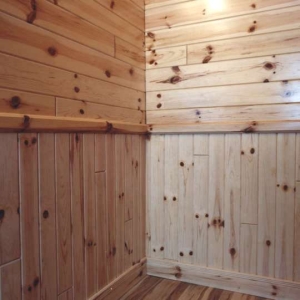 A classic style of wainscoting consists of knotty pine paneling mounted vertically or horizontally as an option. Its height ranges from 32” to 48” above the floor and is topped with wood chair railing (molding). Typical pine paneling is available in 4”, 5”, 6”, and 8” widths and ¾” thick.
A classic style of wainscoting consists of knotty pine paneling mounted vertically or horizontally as an option. Its height ranges from 32” to 48” above the floor and is topped with wood chair railing (molding). Typical pine paneling is available in 4”, 5”, 6”, and 8” widths and ¾” thick.
Beadboard is typically ¾” thick and 4” wide and differs from flat pine paneling in design. It has vertical grooves and small ridges between each board. The grooves and ridges create a beaded effect that gives beadboard its name. This style of wall material originated about 400 years ago as a way to keep heat in rooms and drafts out.
Beadboard Wainscoting
Both knotty pine paneling and beadboard are popular choices because they are durable and affordable materials. They add warmth, character, and a decorative touch to any style of house from farmhouse to modern styles. The wood comes in an unfinished condition for you to finish with a stain color of your choice or only a clear coat finish.
“This type of wall construction is experiencing a steady comeback.”
Wainscoting With Pre-Finished Paneling
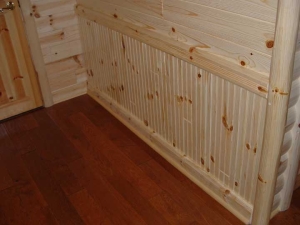 An option to installing unfinished wood paneling is using pre-finished knotty pine paneling. Let our finishing experts do the work for you and all you need to do is install it with these benefits:
An option to installing unfinished wood paneling is using pre-finished knotty pine paneling. Let our finishing experts do the work for you and all you need to do is install it with these benefits:
- Saves up to 50% of the work compared to on-the-job-site finishing and installation
- No delays with weather, scheduling a painter, or cleaning up any messes
- Arrives at your destination already sealed with protection from the elements
- Finish is applied in a controlled environment that meets and exceeds all manufacturers’ warranty requirements
- There are no runs, sags, or over-applications of the finish
Each piece of paneling or beadboard is sealed on the face and all edges that eliminate any unsightly lines as opposed to finishes applied in the field. This professional finish has a durable, non-yellowing, satin sheen that is glassy smooth. Before the first and second coats of finish are applied, each piece is thoroughly sanded to provide a furniture finish to the wood.
How Knotty Pine Paneling And Beadboard Are Installed
Both standard paneling boards and beadboard are individual pieces of wood that fit snugly together with the tongue and groove/end-matching design. Drywall is typically installed under the wood and above it. You have three common choices:
- Vertically installed wood needs short horizontal blocks nailed or screwed into the wall framing to provide places to secure the paneling
- Horizontally installed wood is secured to the wall framing with nails or screws
- Diagonally installed wood also needs short wood blocks nailed or screwed into the wall framing for support
- Chair Railing is a type of trim or molding that is placed on top of the wood with nails that covers a small portion of the top of the paneling
Finishing Your Knotty Pine Paneling And Beadboard
You have the choice of applying stain and/or a clear coat of finish before or after installing unfinished wainscoting. The other option is purchasing pre-finished wood in a stain color to meet your needs. Whitewash stain is another option to lighten up a room.
Wainscoting one, two, or all walls in a room can look anywhere from rustic to elegant. Before purchasing either product, check our prices and the cost of hiring a painter to compare the overall project.


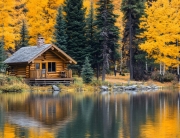
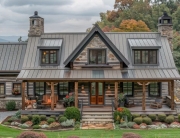
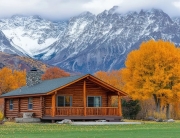
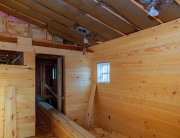
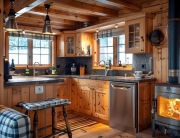
Recent Comments